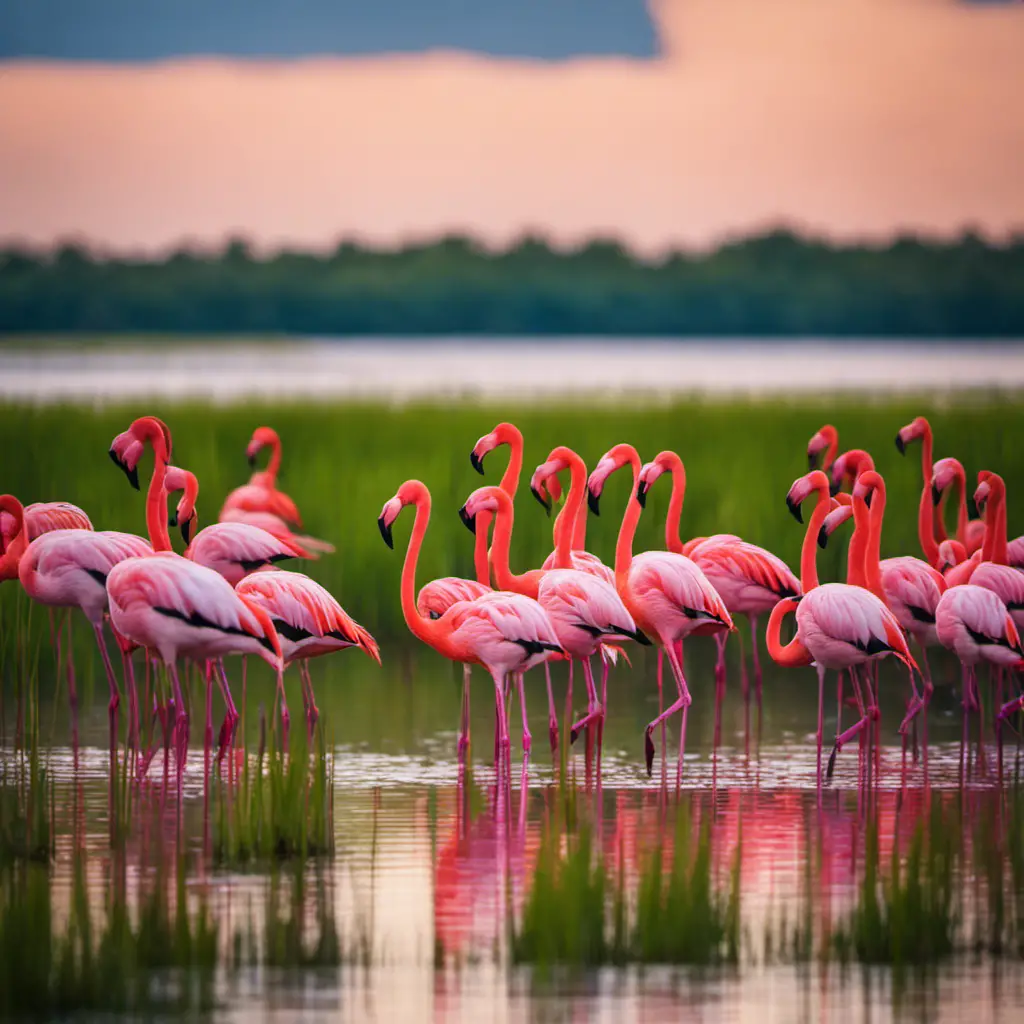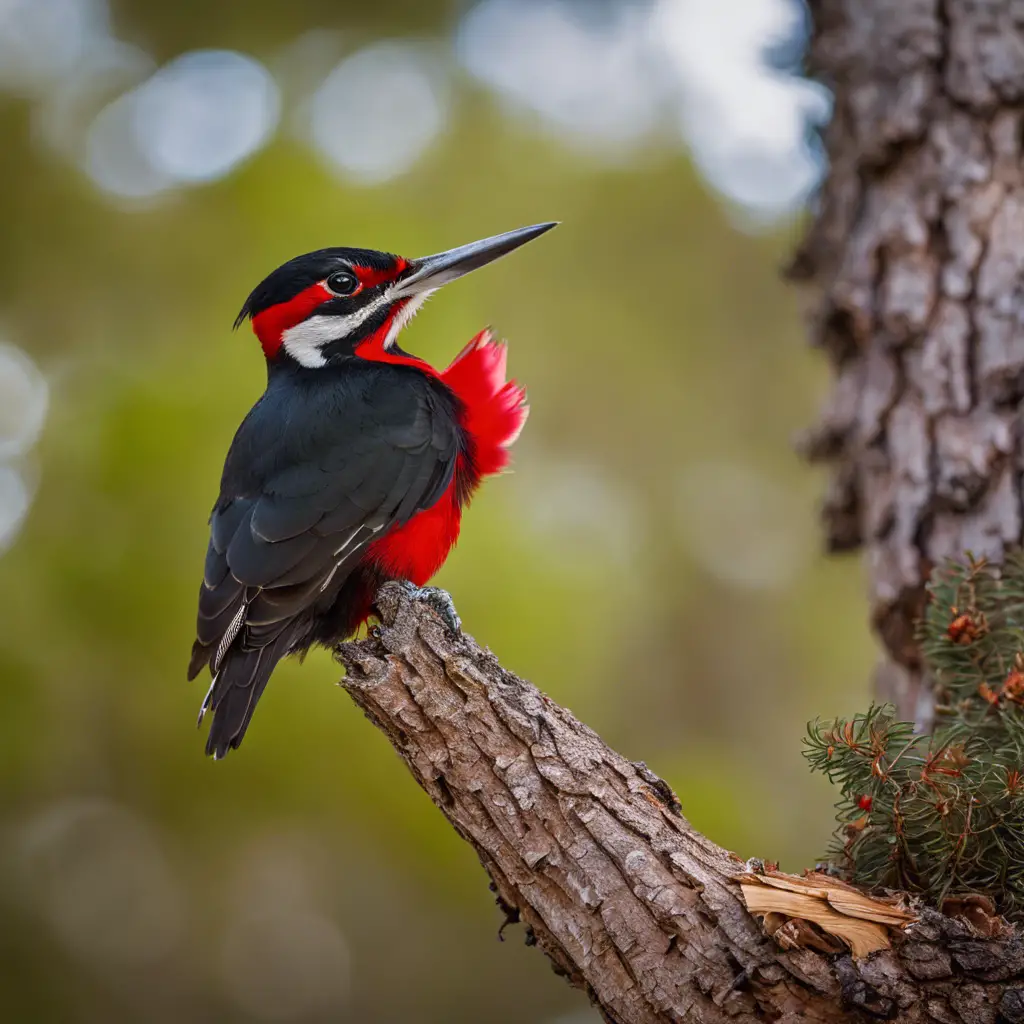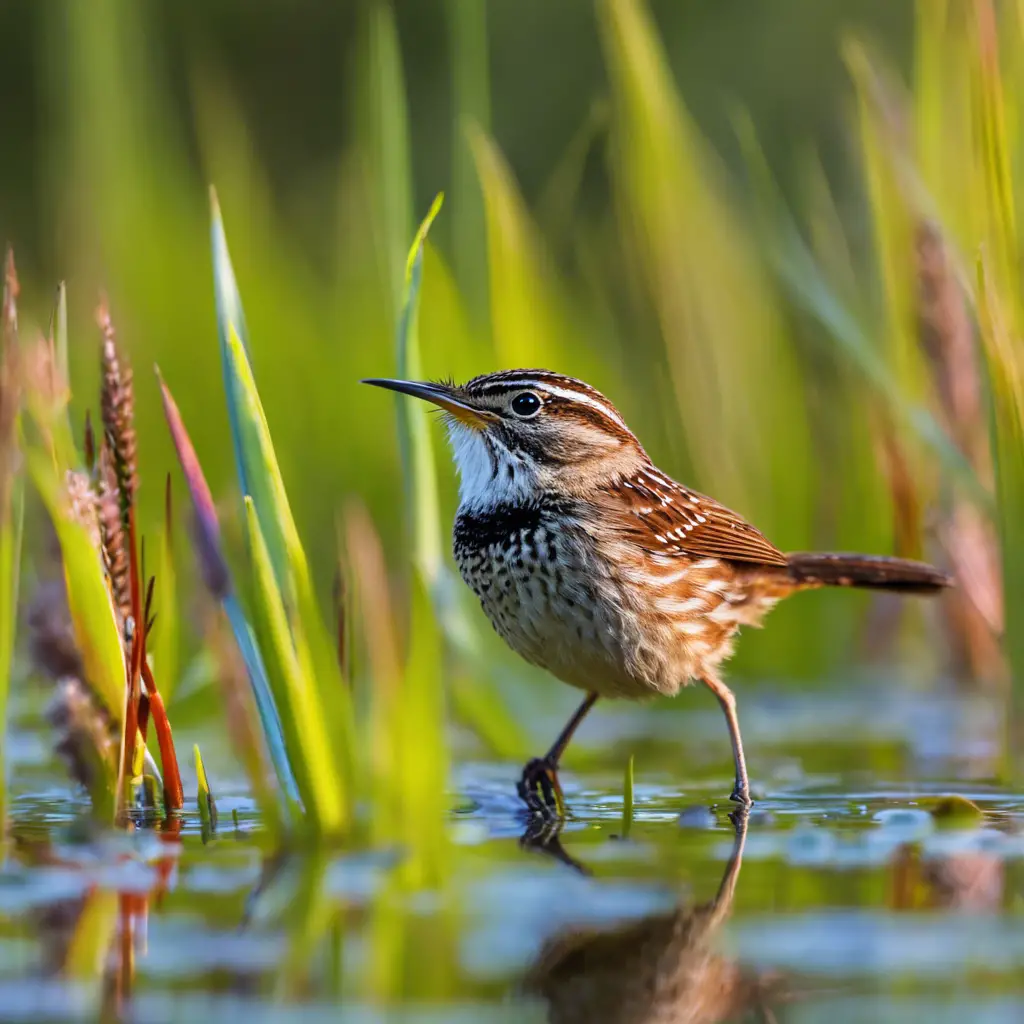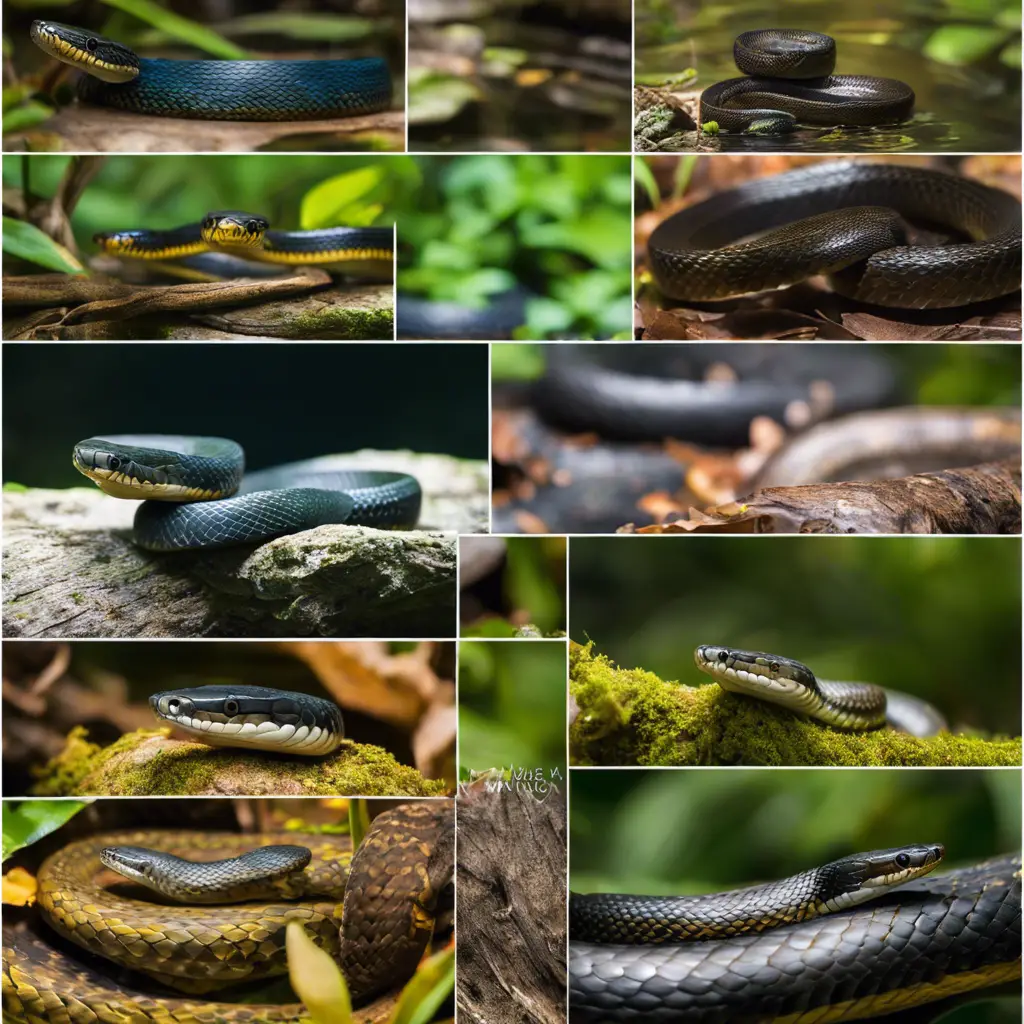In the vibrant ecosystems of Florida, a stunning array of pink-hued avian species graces the marshlands and coastal regions. From the elegant Roseate Spoonbill with its distinctive spoon-shaped bill to the graceful American Flamingo, these pink birds captivate the attention of both nature enthusiasts and scientific researchers.
This article delves into the fascinating world of these pink birds, exploring their unique characteristics, habitats, and conservation efforts. Join us as we unravel the secrets of these magnificent creatures and gain a deeper understanding of their vital role in Florida’s biodiversity.
Key Takeaways
- Pink birds in Florida include the Roseate Spoonbill, Flamingo, American Flamingo, Scarlet Ibis, and Roseate Tern.
- Conservation efforts focus on protecting habitats and reducing disturbances caused by human activities, as these birds are threatened by habitat loss, pollution, and climate change.
- These birds have unique feeding behavior using specialized bills with comb-like structures, and efforts are being made to protect their habitats and ensure their survival for future generations.
- Other wading birds found in Florida include the Glossy Ibis, White Ibis, Wood Stork, Great Egret, Green Heron, Black-crowned Night-Heron, Limpkin, Purple Gallinule, and Common Moorhen.
Roseate Spoonbill
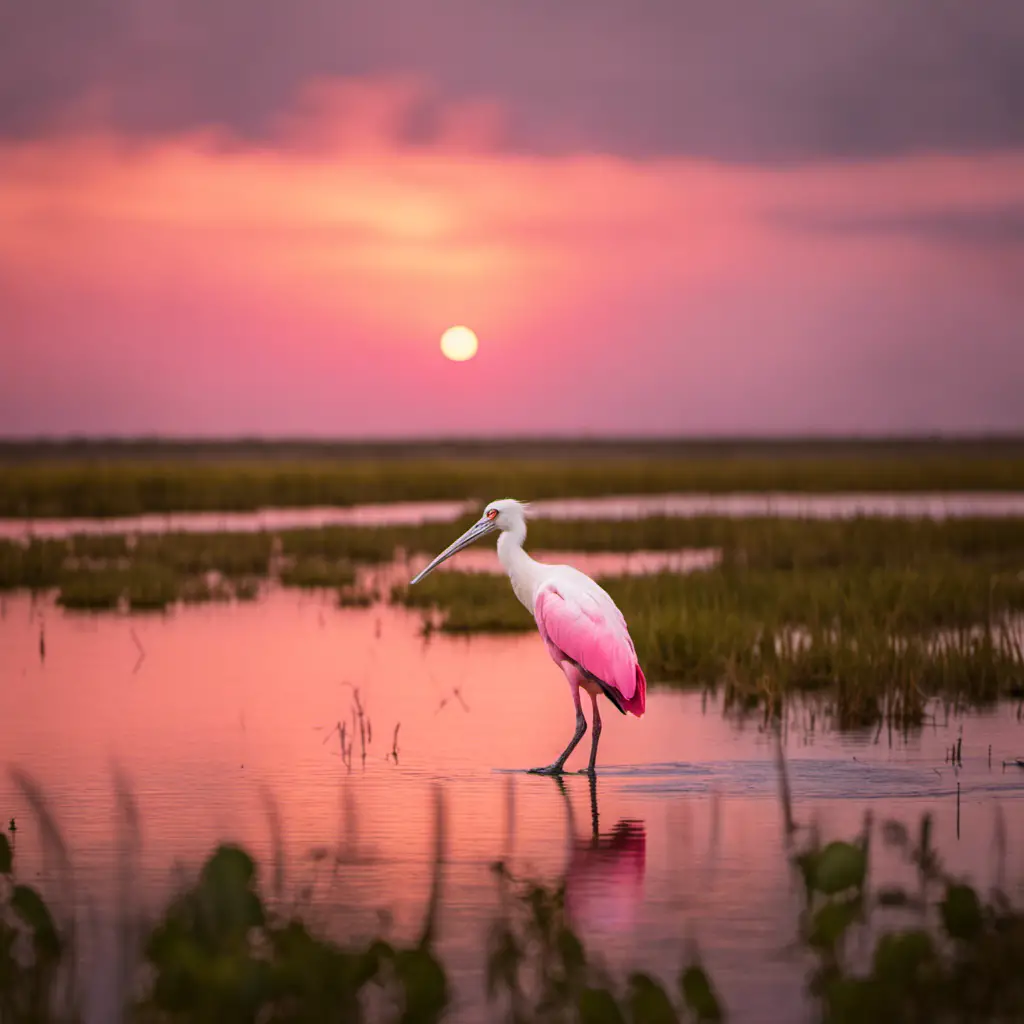
During the current discussion on Roseate Spoonbills, it is important to consider their habitat preferences and the impact of human activities on their population.
Roseate Spoonbills are known for their vibrant pink plumage and distinctive spoon-shaped bills. They are primarily found in coastal wetlands, marshes, and mangrove forests in the southeastern United States, particularly in Florida.
These birds are highly migratory, with some individuals traveling as far north as the Great Lakes region during the breeding season. Understanding their migration patterns is crucial for their conservation, as it helps identify key stopover sites and areas where they may face threats.
Conservation efforts for Roseate Spoonbills focus on protecting their habitats, such as through the establishment and management of protected areas, as well as reducing disturbances caused by human activities, such as habitat destruction and pollution.
Flamingo
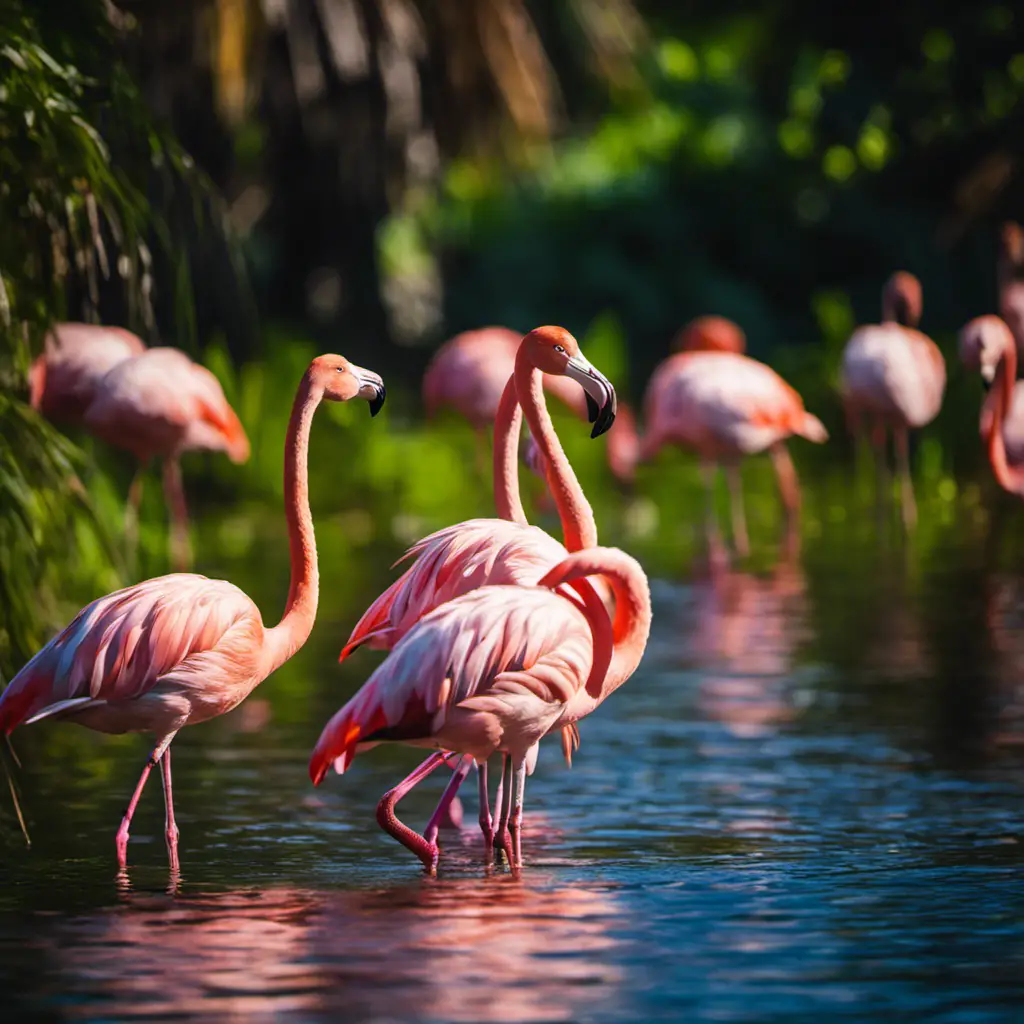
The flamingo, a majestic bird with its iconic pink plumage, is a fascinating species that captivates the attention of wildlife enthusiasts worldwide. Here are four interesting facts about flamingos:
Flamingo Conservation: Flamingos are facing numerous threats, including habitat loss, pollution, and climate change. Conservation efforts are crucial to protect their populations and habitats. Organizations such as the Flamingo Specialist Group and the International Union for Conservation of Nature (IUCN) are working towards raising awareness and implementing conservation strategies.
Flamingo Migration Patterns: Flamingos are known for their long-distance migrations. They travel in large flocks, sometimes consisting of thousands of individuals, to find suitable feeding and breeding grounds. These migratory journeys can span hundreds or even thousands of kilometers, highlighting the importance of preserving these critical habitats.
Feeding Habits: Flamingos have a unique feeding behavior. They use their specialized bills to filter small organisms, such as algae and crustaceans, from the water. Their bills contain comb-like structures called lamellae, which help in capturing and straining their food.
Social Behavior: Flamingos are highly social birds, often seen in large colonies. These colonies serve various purposes, including finding mates, protecting against predators, and sharing foraging knowledge. Their synchronized movements and elaborate courtship displays are a sight to behold.
Understanding the conservation needs and migration patterns of these magnificent birds is vital for their long-term survival. By protecting their habitats and implementing effective conservation measures, we can ensure the continued presence of flamingos in our ecosystems.
American Flamingo
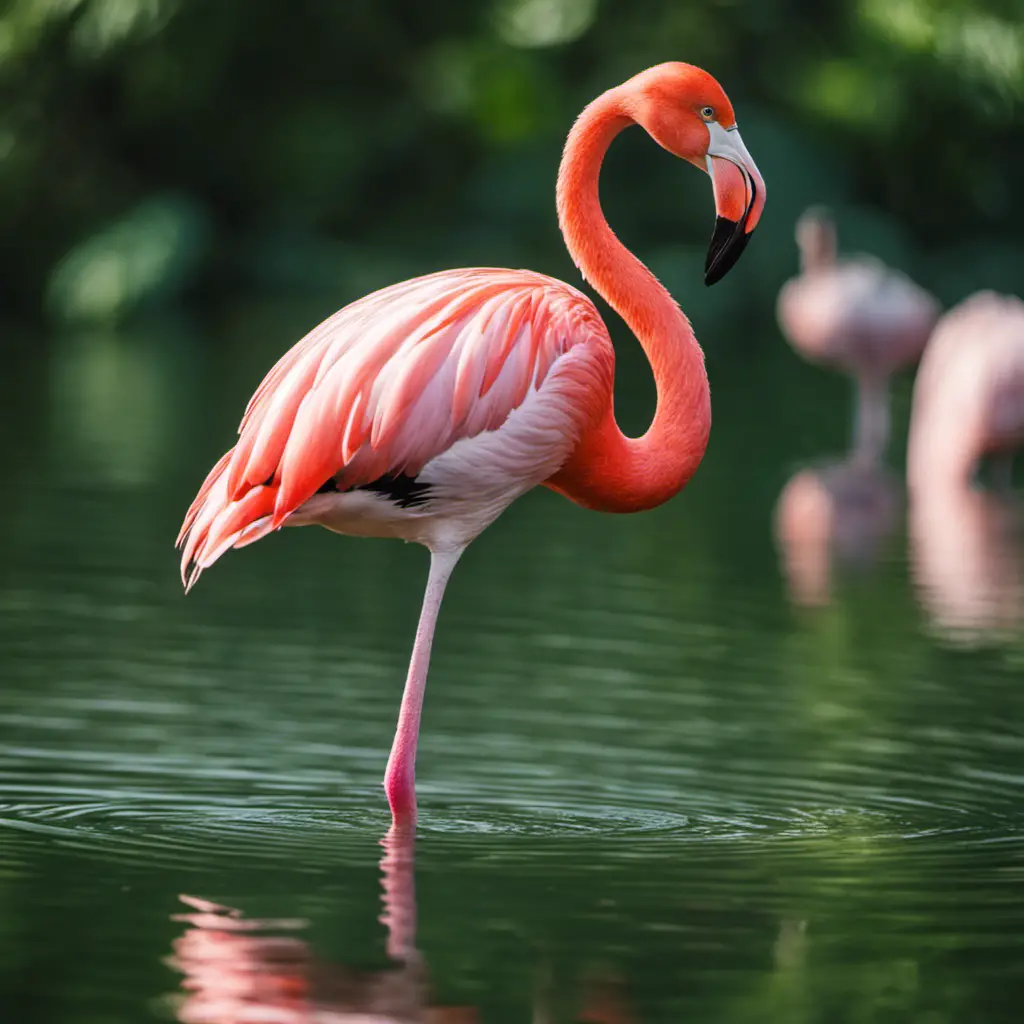
An article about the American Flamingo is an informative resource for understanding the unique characteristics and conservation efforts surrounding this captivating bird. The American Flamingo, scientifically known as Phoenicopterus ruber, is a large wading bird that is well-known for its vibrant pink plumage and gracefully curved neck. It is primarily found in the Caribbean and South America, but can also be spotted in the southernmost parts of Florida. This species has several unique characteristics, including its ability to stand on one leg for extended periods of time and its filter-feeding behavior, where it uses its specialized beak to strain small organisms from water. Unfortunately, the American Flamingo is facing habitat conservation challenges due to habitat loss, pollution, and disturbance. Efforts are being made to protect their habitats and ensure their survival for future generations.
| Characteristics | Conservation Efforts | Habitat |
|---|---|---|
| Vibrant pink plumage | Protection of breeding sites | Coastal areas and lagoons |
| Curved neck | Reducing pollution | Wetlands and marshes |
| Filter-feeding behavior | Restoring nesting sites | Salt pans and mudflats |
Scarlet Ibis
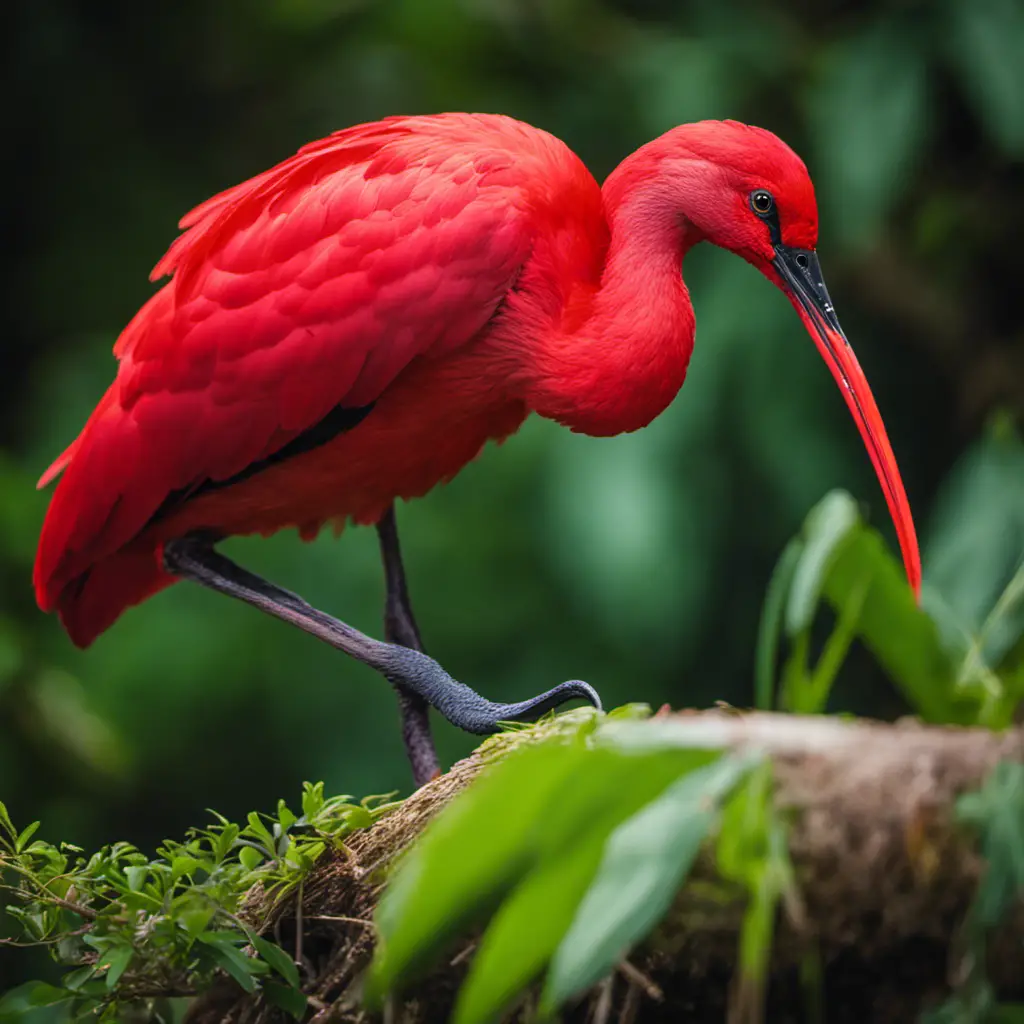
The Scarlet Ibis, native to South America and known for its striking red plumage, is a bird that holds significant cultural and symbolic importance in various indigenous communities. This magnificent bird has sparked discussions and efforts surrounding its migration patterns and conservation. Here are four key points to consider:
Scarlet Ibis Migration: These birds are known to undertake long-distance migrations, traveling from their breeding grounds in South America to other parts of the continent. The specific routes and destinations of their migrations are still being studied and understood.
Habitat Loss: The destruction of wetland habitats, where Scarlet Ibises often reside, poses a threat to their population. Urbanization, deforestation, and pollution have contributed to the decline in suitable habitats for these birds.
Conservation Efforts: Conservation organizations, such as bird sanctuaries and wildlife reserves, are working towards protecting the Scarlet Ibis and its habitats. These efforts include habitat restoration, captive breeding programs, and public awareness campaigns.
Cultural Significance: The Scarlet Ibis holds immense cultural and symbolic importance in indigenous communities. It is considered a sacred bird and plays a significant role in traditional ceremonies and folklore.
Understanding the migration patterns and conservation efforts surrounding the Scarlet Ibis is crucial for ensuring the survival of this magnificent species. By protecting their habitats and raising awareness, we can contribute to the preservation of this culturally significant bird.
Roseate Tern
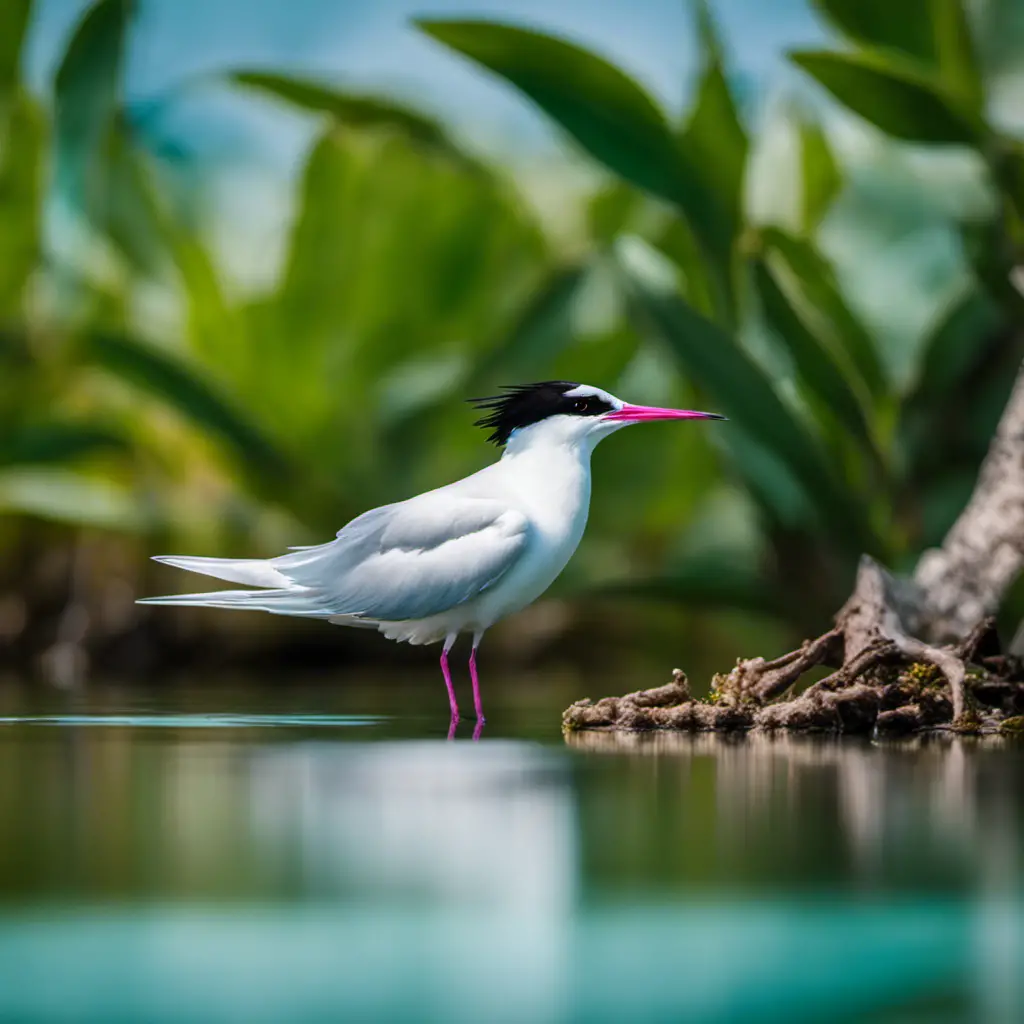
Conservationists are monitoring and studying the migration patterns of Roseate Terns, as well as implementing measures to protect their breeding grounds and ensure their long-term survival.
Roseate Terns are small seabirds that are known for their beautiful pink plumage and graceful flight. They are found in coastal areas across the globe, with nesting habitats primarily located on sandy beaches, dunes, and islands.
These birds are highly migratory, traveling long distances during the non-breeding season. By tracking their movements and understanding their nesting habits, conservationists can identify critical areas for protection and establish measures to reduce disturbances and threats to their breeding grounds.
Efforts are being made to create safe nesting areas, such as installing fencing to prevent predation and human disturbance. Additionally, conservationists are working to raise awareness about the importance of roseate tern conservation to ensure the long-term survival of these magnificent birds.
Caribbean Flamingo
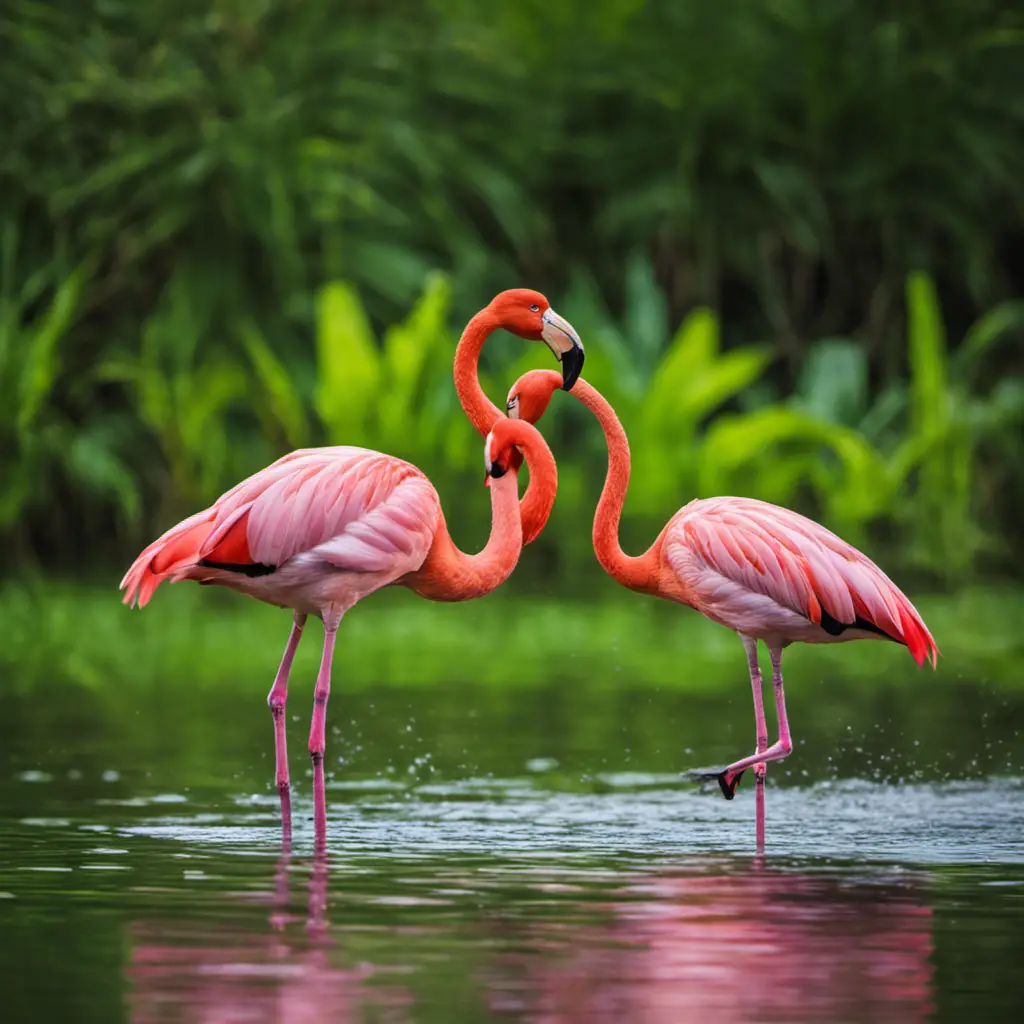
During their annual migration, Caribbean Flamingos gather in large flocks on the coast of Florida, showcasing their vibrant plumage as they forage for food in the shallow waters. These iconic birds, with their long legs and curved bills, are a sight to behold. However, their population has been declining due to various factors such as habitat loss and human disturbance.
To ensure the conservation of Caribbean Flamingos, it is crucial to protect their natural habitat and raise awareness about the importance of these birds in the ecosystem. Here are four key aspects of Caribbean Flamingo conservation:
Habitat preservation: Protecting the coastal areas where flamingos gather for feeding and breeding is essential to their survival. This includes preserving mangrove forests, marshes, and other wetland habitats.
Reduction of human disturbance: Minimizing human activities such as tourism and development near flamingo habitats is necessary to reduce stress and disturbance to the birds.
Monitoring and research: Regular monitoring of flamingo populations and conducting scientific research allows for a better understanding of their ecology and helps in implementing effective conservation strategies.
Education and outreach: Educating the public about the importance of Caribbean Flamingos and their conservation needs is vital. This can be done through awareness campaigns, educational programs, and community involvement.
Glossy Ibis
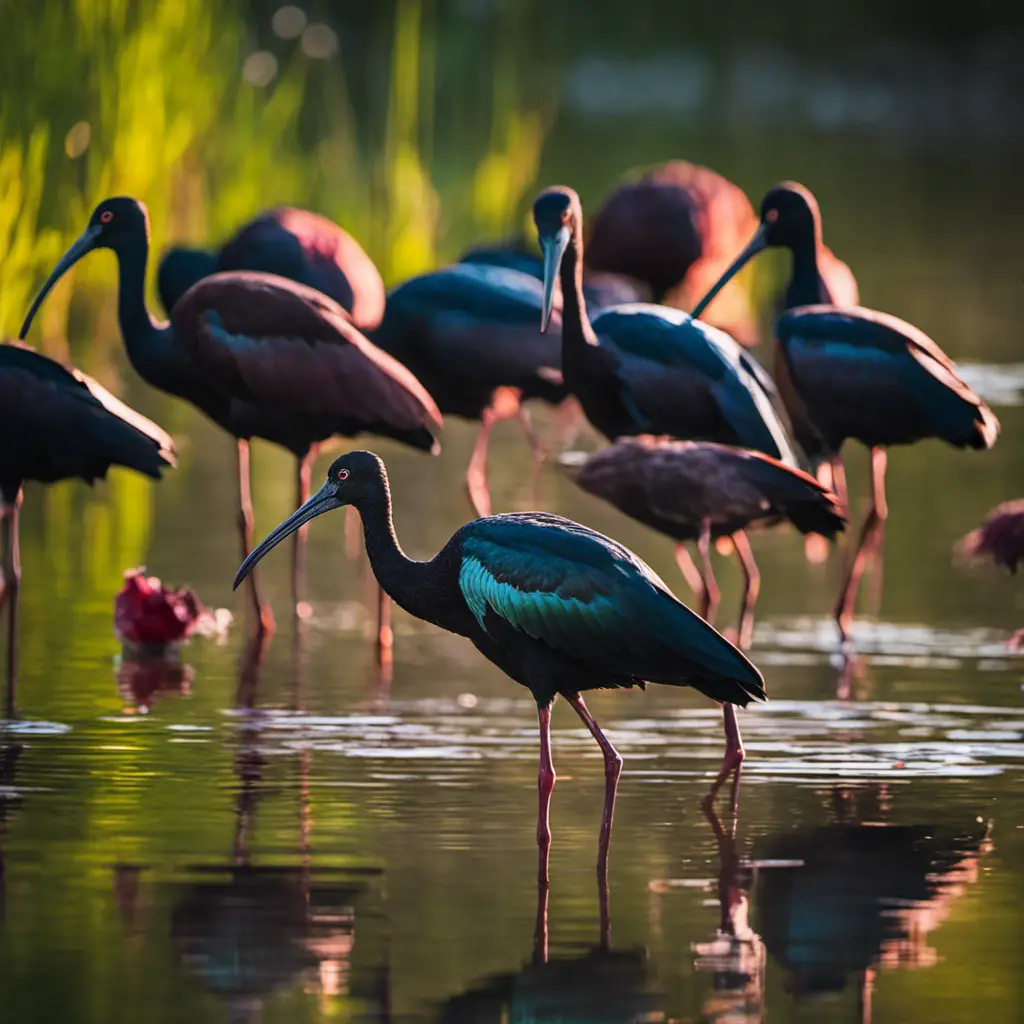
Several Glossy Ibis and their unique iridescent feathers can be spotted along the coast of Florida, as they migrate to find suitable feeding grounds. Glossy Ibis (Plegadis falcinellus) is a wading bird that belongs to the family Threskiornithidae. They are medium-sized birds, measuring around 55-65 cm in length, with a wingspan of about 88-105 cm. These ibises are known for their striking glossy plumage, which ranges from deep maroon to dark green. They inhabit wetland areas such as marshes, swamps, and mudflats, where they feed on a variety of invertebrates, including insects, crustaceans, and small fish.
The conservation status of Glossy Ibis is of least concern, as their population is relatively stable. However, they face certain threats, including habitat loss due to urbanization and agriculture, pollution of water bodies, and disturbance from human activities. Wetland conservation efforts are crucial to ensure the survival of this species. It is important to protect and restore their habitats, regulate human activities in these areas, and raise awareness about the importance of conserving wetlands for the survival of species like the Glossy Ibis.
White Ibis
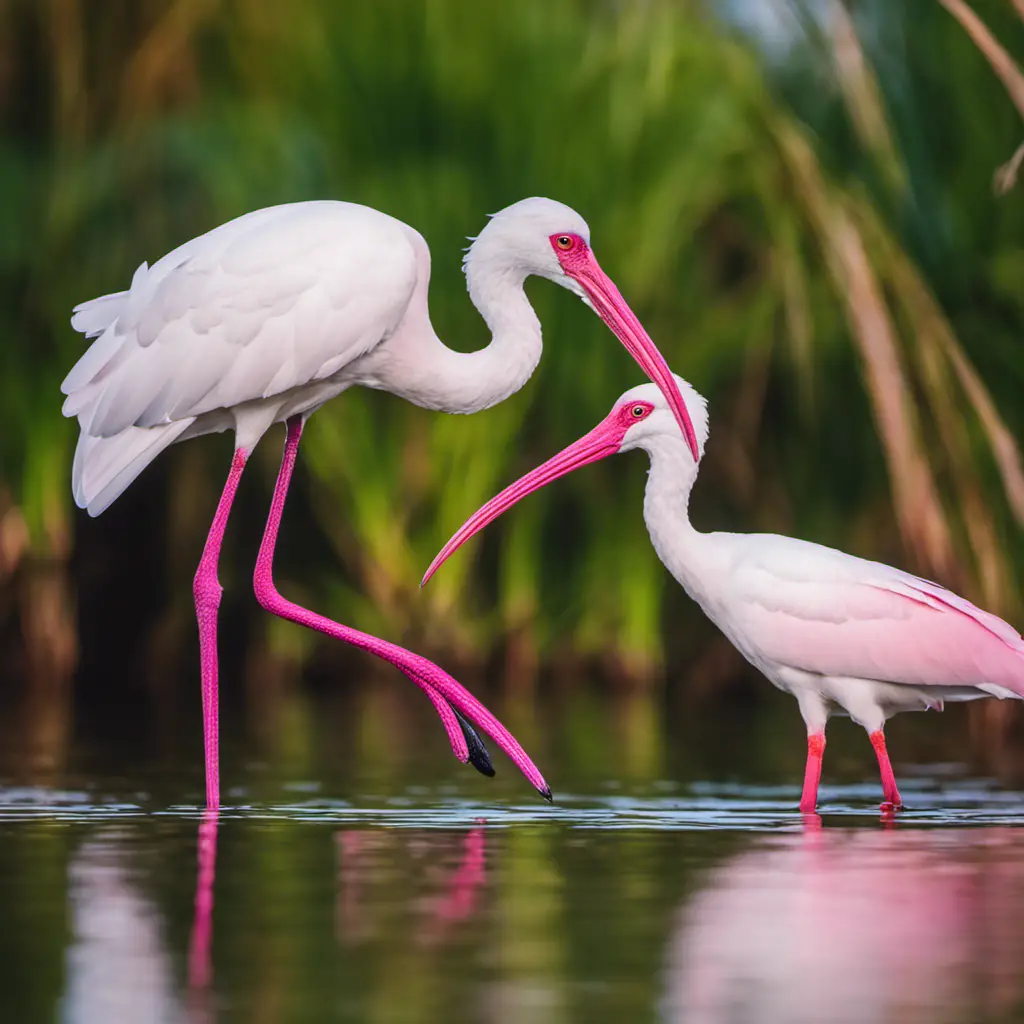
The White Ibis, a common wading bird found in Florida, is known for its distinctive white plumage and long, curved bill. This beautiful bird can be found in a variety of habitats, including marshes, swamps, and wetlands. It is often seen foraging in shallow water, using its long bill to search for small aquatic creatures such as insects, crustaceans, and small fish.
Here are four interesting facts about the White Ibis:
Breeding: White Ibises form large colonies during the breeding season, nesting in trees and shrubs near water. They build platform nests made of sticks and twigs.
Plumage: Juvenile White Ibises have brown plumage, which gradually turns white as they mature. Adult birds have a reddish-pink face and legs.
Feeding Behavior: White Ibises are known for their probing feeding behavior. They walk slowly through the water, probing the mud with their bill to find food.
Conservation Status: The White Ibis is listed as a species of least concern by the International Union for Conservation of Nature (IUCN). However, habitat loss and pollution remain ongoing threats to their populations.
Wood Stork
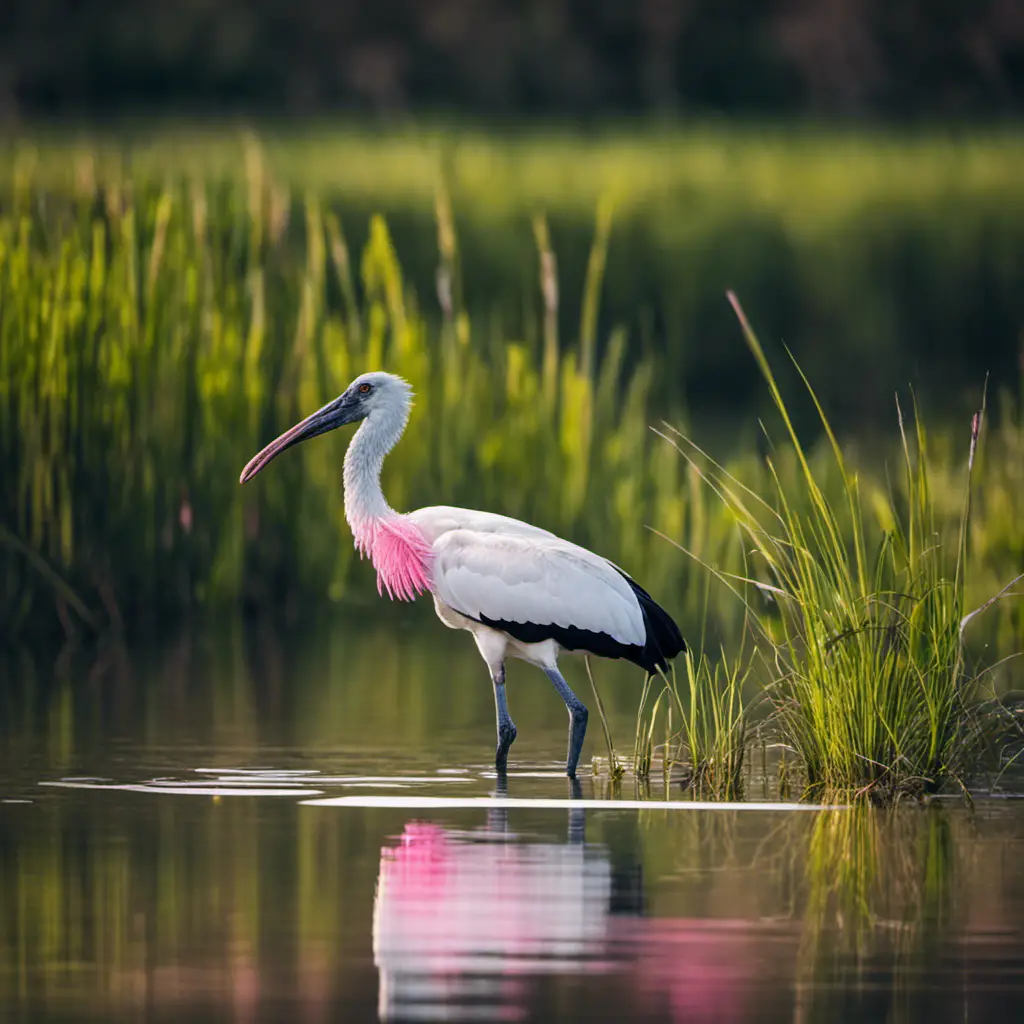
Approximately 5,000 Wood Storks, a federally endangered bird species, reside in Florida, primarily nesting in cypress swamps and wetlands. These large wading birds are known for their unique appearance, with white feathers and a bald, scaly head.
Wood Storks are migratory, and during the breeding season, they may travel long distances in search of suitable nesting sites. However, their migration patterns have been disrupted due to habitat loss. The destruction of wetlands and cypress swamps, caused by urbanization and agriculture, has resulted in a significant reduction in available nesting areas for Wood Storks.
This loss of habitat has had a detrimental impact on their population, making conservation efforts crucial for their survival. Protecting and restoring wetlands and implementing measures to prevent further habitat loss are vital steps in ensuring the continued existence of this endangered species.
Great Egret
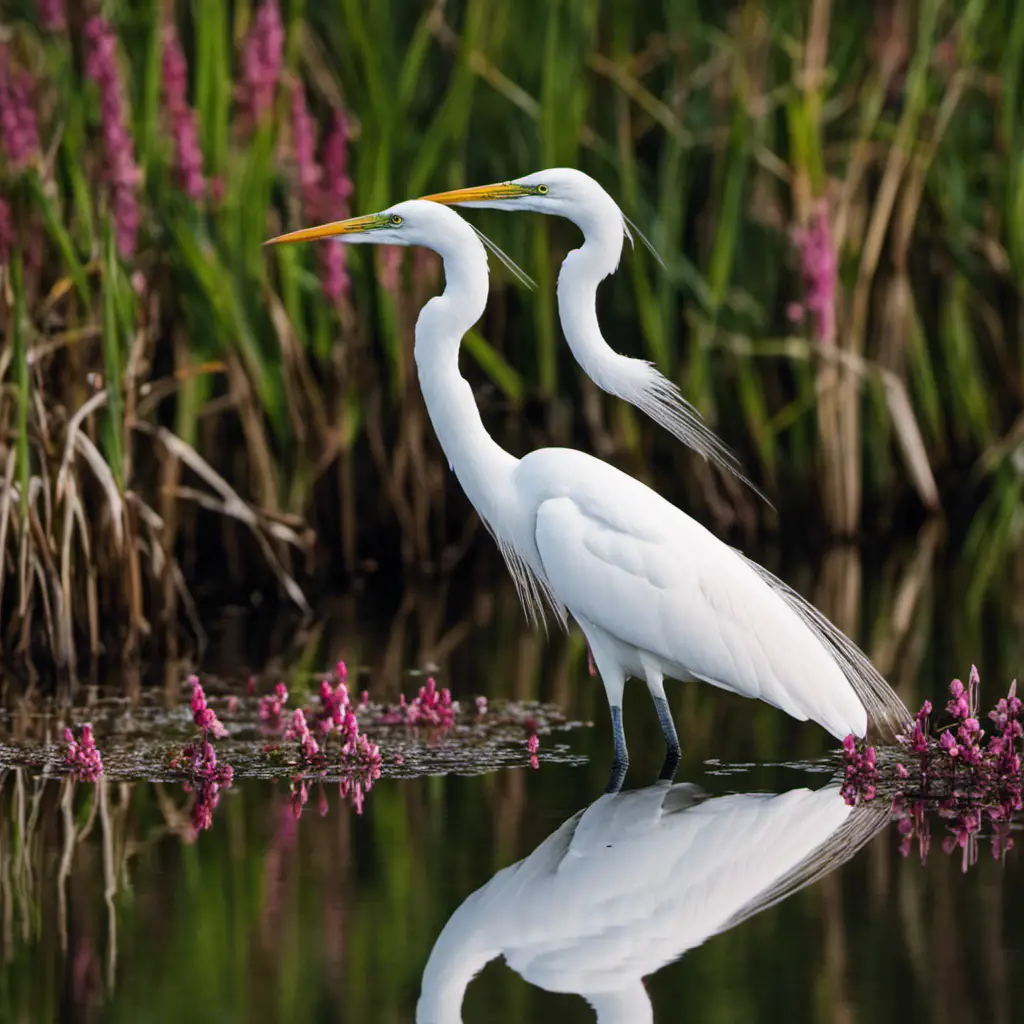
Observing the elegant movements and graceful flight of the Great Egret, as well as its impressive fishing skills, can be a captivating experience for birdwatchers. This majestic bird, also known as Ardea alba, is found in various parts of the world, including North America, Europe, and Asia.
Here are four interesting facts about the Great Egret:
Conservation: The Great Egret has faced significant challenges due to habitat loss and hunting in the past. However, conservation efforts have helped stabilize their populations. Conservation organizations work to protect their wetland habitats and reduce disturbance during their breeding season.
Migration Patterns: Great Egrets are migratory birds, moving between breeding and wintering grounds. In North America, they breed in colonies in the southern parts of the United States and Mexico, and then migrate to Central and South America for the winter.
Nesting Behavior: Great Egrets build large stick nests in trees or shrubs, often in colonies alongside other herons and egrets. Both parents take turns incubating the eggs and feeding the chicks once they hatch.
Feeding Habits: Great Egrets are skilled fishermen. They wade in shallow water, patiently waiting for their prey to come near. With lightning-fast strikes, they catch fish, amphibians, reptiles, and even small mammals. Their long, sharp bills and agile necks aid in capturing their prey.
Understanding these aspects of egret conservation and egret migration patterns contributes to our knowledge and appreciation of this fascinating species.
Snowy Egret
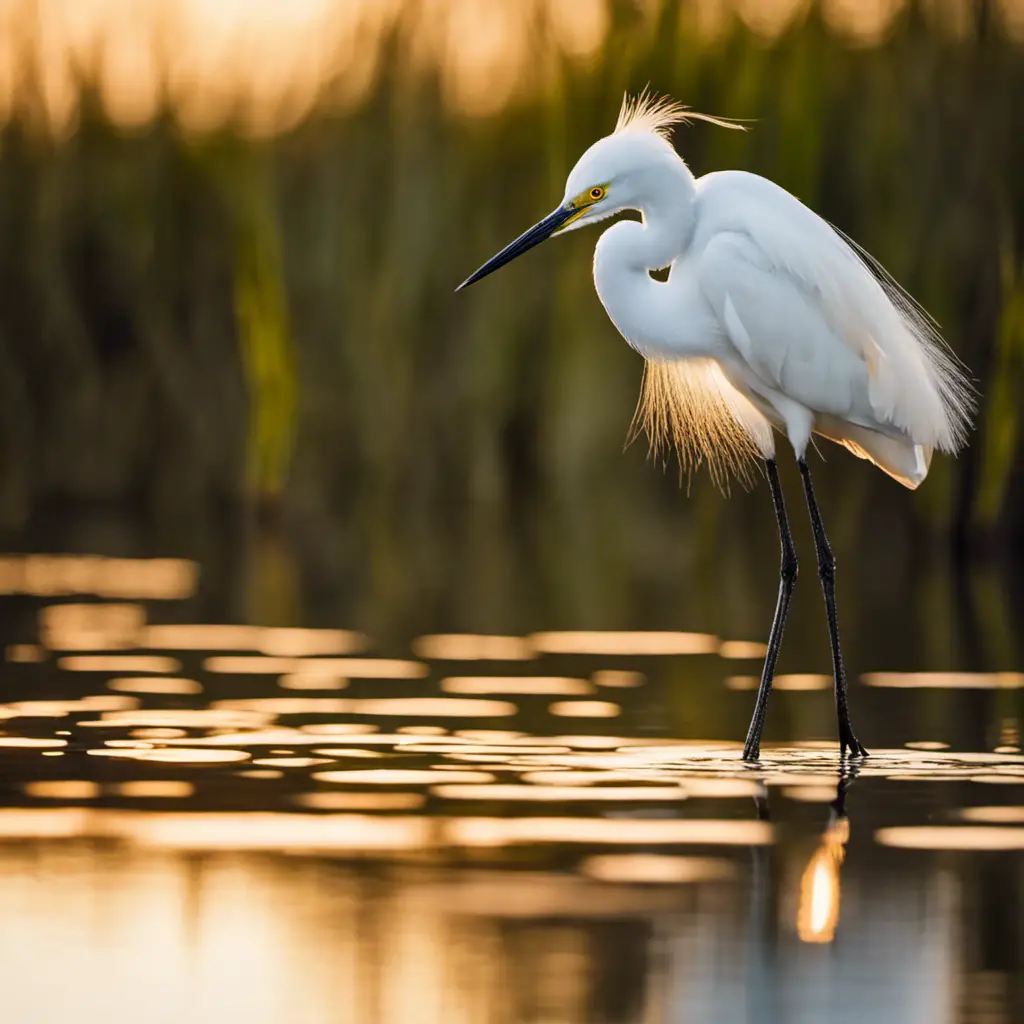
As we study the behavior of the Snowy Egret, it is fascinating to observe its delicate balance while foraging for prey in shallow waters.
The Snowy Egret (Egretta thula) is a small, white heron that is commonly found in wetland habitats throughout North and South America. This bird is known for its elegant appearance, with its long, slender neck, bright yellow feet, and distinctive plumes on its head and back during the breeding season.
Snowy Egrets are skilled hunters, using their sharp beaks and quick movements to catch small fish, crustaceans, and insects in the water. They are also known for their unique foraging behavior, where they use their feet to stir up the sediment at the bottom of the water, flushing out hidden prey.
Despite their resilience and adaptability, Snowy Egrets face threats to their populations, including habitat loss, pollution, and disturbance. Conservation efforts are crucial to ensure the survival of these beautiful birds and the ecosystems they inhabit.
Little Blue Heron
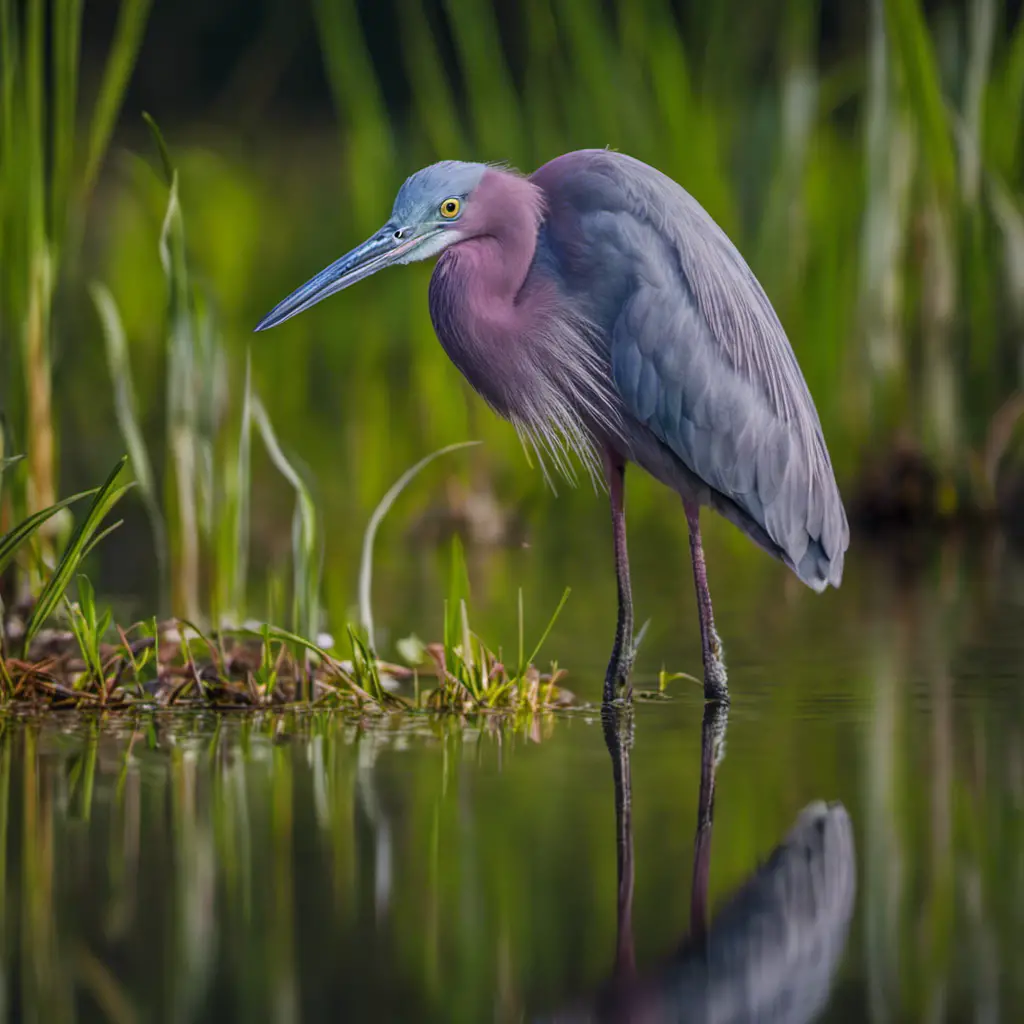
A few Little Blue Herons were spotted in the wetland, and they were seen gracefully hunting for small fish and crustaceans. These elegant birds have fascinating nesting habits, diet, and behavior. Here are some key points to understand about the Little Blue Heron:
Nesting Habits: Little Blue Herons typically build their nests in trees or shrubs near water bodies. They often nest in colonies, along with other wading birds.
Diet: Their diet mainly consists of small fish, amphibians, crustaceans, and insects. They use their sharp beaks to catch and consume their prey.
Behavior: Little Blue Herons are known for their solitary nature during the non-breeding season. However, during the breeding season, they become more social and form breeding colonies.
Conservation Efforts, Population Status, and Threats: The Little Blue Heron population is currently stable. However, habitat loss, disturbance, and pollution pose threats to their survival. Conservation efforts include protecting and restoring wetland habitats, regulating water quality, and minimizing disturbances in their breeding areas.
Understanding these aspects of the Little Blue Heron helps us appreciate and work towards the conservation of this beautiful species.
Tricolored Heron
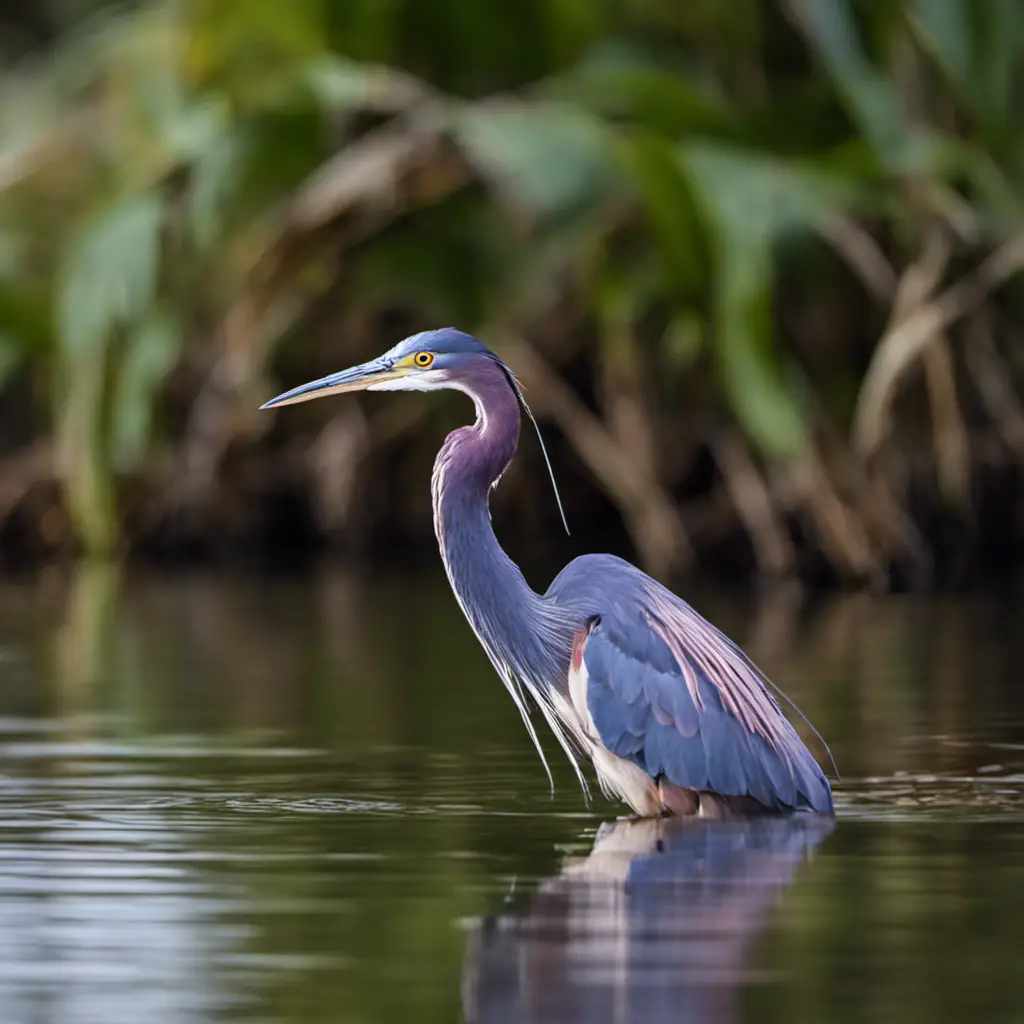
During the breeding season, the Tricolored Heron can be found nesting in colonies alongside other wading birds, showcasing its social behavior. This bird, scientifically known as Egretta tricolor, is typically found in wetland habitats such as marshes, swamps, and mangroves along the coastal areas of the southeastern United States and the Caribbean.
The Tricolored Heron is known for its distinctive appearance, with a blue-gray body, a white belly, and a reddish-brown neck and head during breeding season. It has a slender build and long, thin legs, which are adapted for wading in shallow water to catch its prey, primarily small fish and invertebrates.
The Tricolored Heron’s social behavior during the breeding season includes nesting in close proximity to other wading birds, forming mixed-species colonies that provide safety in numbers. This behavior allows for increased opportunities for successful breeding and protection from predators.
Understanding bird behavior and their preferred habitats is crucial for conservation efforts and the preservation of these important ecosystems.
Cattle Egret
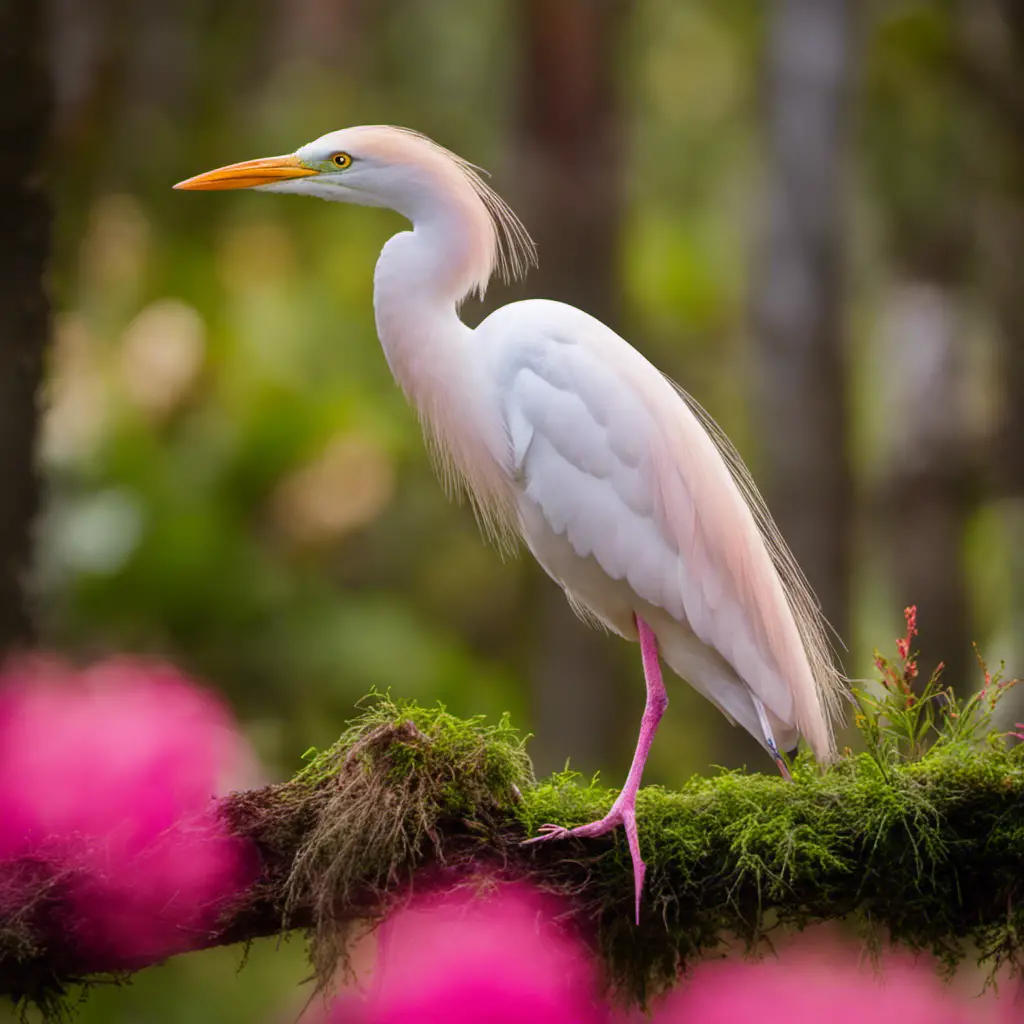
The Cattle Egret is commonly seen foraging in large numbers alongside herds of cattle, a behavior that showcases their affinity for grazing animals. These elegant birds have fascinating nesting habits and migration patterns, which contribute to their success as a species.
Here are some key facts about the Cattle Egret:
Nesting habits: Cattle Egrets build their nests in colonies, often in trees or shrubs near bodies of water. They construct their nests using sticks and vegetation, and both males and females participate in nest-building. These colonies can contain hundreds or even thousands of nests, providing safety in numbers.
Migration patterns: Cattle Egrets are migratory birds, with some populations traveling long distances to reach their breeding grounds. They are known to migrate from their wintering grounds in Africa and Asia to their breeding grounds in Europe, North America, and South America. Their migration routes can span thousands of miles and often follow predictable patterns.
Understanding the nesting habits and migration patterns of the Cattle Egret is crucial for conservation efforts and protecting their populations worldwide. By studying their behaviors, scientists can gain insights into their ecological role and implement strategies to ensure their continued survival.
Green Heron
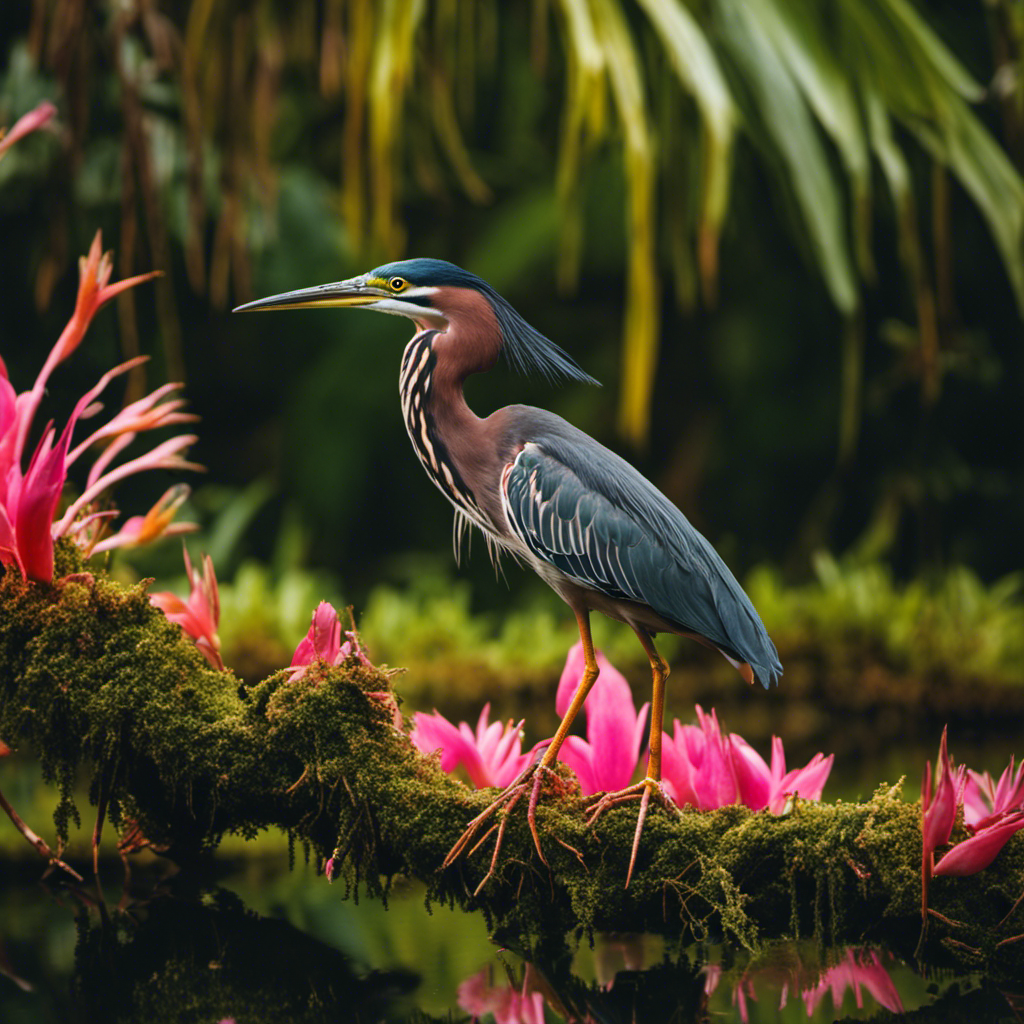
In order to fully understand the ecological role of the Green Heron, researchers must closely observe its foraging techniques and nesting behaviors, as well as analyze its impact on local ecosystems. The Green Heron (Butorides virescens) is a small heron commonly found in wetland habitats across North and Central America. It is known for its unique foraging technique of using bait, such as insects or small objects, to attract fish and other prey. The Green Heron also exhibits interesting nesting behaviors, often building its nests in dense vegetation near water bodies. By studying the Green Heron, researchers can gain valuable insights into wetland conservation and the overall health of ecosystems. Bird watching enthusiasts can contribute to this research by observing and reporting sightings of Green Herons in their local areas. The following table provides an overview of the Green Heron’s key characteristics:
| Characteristic | Description |
|---|---|
| Habitat | Wetlands |
| Size | 16-18 inches tall |
| Diet | Fish, insects, small vertebrates |
| Breeding Behavior | Builds nests in dense vegetation near water |
| Conservation Status | Least Concern |
Understanding the Green Heron’s role in the ecosystem is crucial for effective wetland conservation efforts. By preserving their habitats and ensuring the availability of suitable nesting and foraging areas, we can contribute to the conservation of this species and the overall health of wetland ecosystems.
Black-crowned Night-Heron

Researchers are currently studying the foraging behavior of the Black-crowned Night-Heron to determine its impact on local fish populations. This species of heron is known for its unique feeding habits and conservation efforts have been focused on understanding its ecological role.
Here are four key aspects being explored:
Foraging Techniques: Scientists are observing how the Black-crowned Night-Heron hunts for fish. They are particularly interested in its ability to adapt to different environments and the strategies it employs to catch prey.
Diet Composition: By analyzing regurgitated pellets and studying stomach contents, researchers are identifying the variety of fish species consumed by the heron. This information helps assess the potential impact of the heron on local fish populations.
Seasonal Variation: Breeding habits of the Black-crowned Night-Heron are also being investigated. Researchers are examining how the heron’s foraging behavior changes during breeding seasons, and how this may affect the availability of fish resources for other species.
Conservation Implications: Understanding the foraging behavior of the Black-crowned Night-Heron is crucial for developing effective conservation strategies. This knowledge can help protect both the heron and its prey, ensuring the balance of local ecosystems.
Limpkin
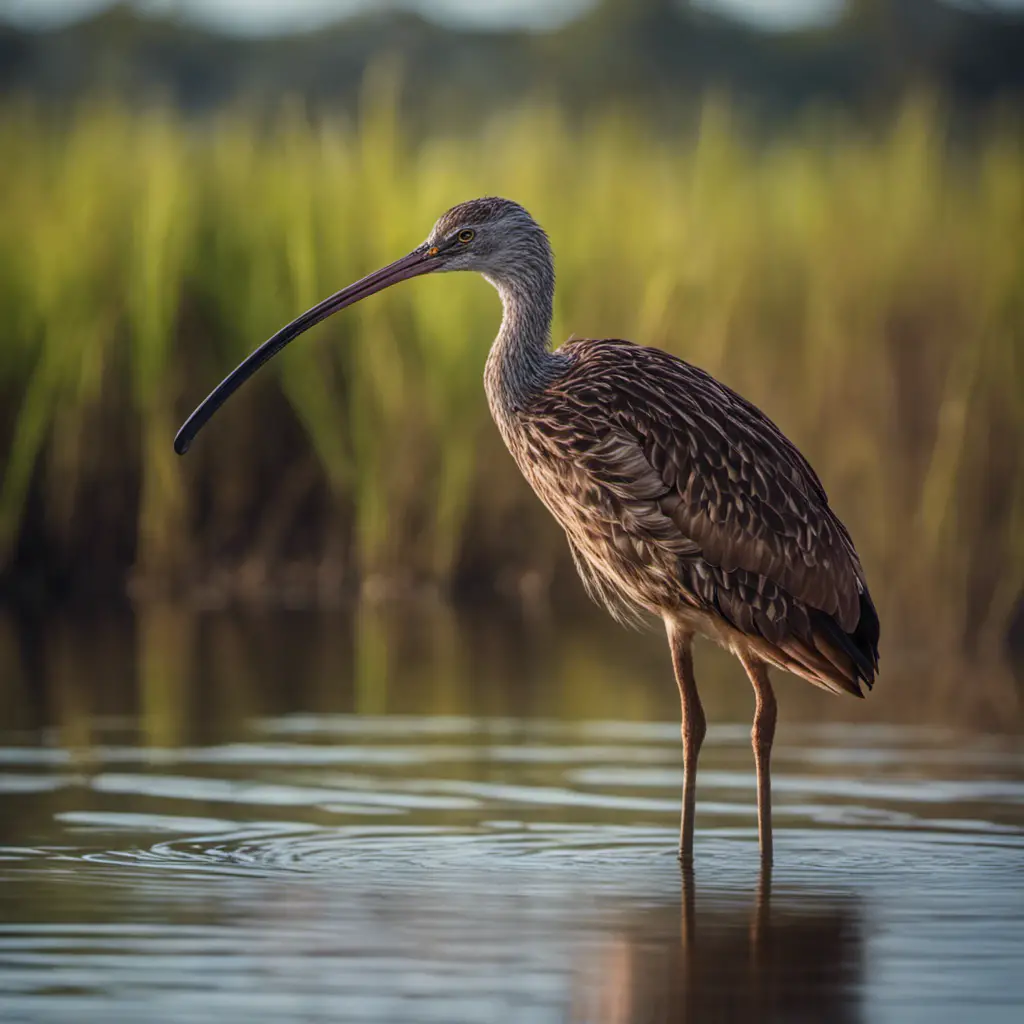
The diet composition of the Black-crowned Night-Heron includes a variety of fish species, while the Limpkin primarily feeds on snails and mussels. Limpkins are unique birds found in the wetlands of Florida. Their feeding habits are crucial to their survival and play a significant role in the ecosystem. Limpkins have a long, curved bill that is perfectly adapted for extracting snails and mussels from their shells. This specialized feeding behavior sets them apart from other birds in the region. To understand the importance of Limpkin conservation, it is essential to recognize their role as primary consumers of snails and mussels. These birds help control the population of these mollusks, preventing overgrowth and maintaining the ecological balance of the wetlands. A table highlighting the diet of both the Black-crowned Night-Heron and the Limpkin is provided below:
| Species | Diet Composition |
|---|---|
| Black-crowned Night-Heron | Variety of fish species |
| Limpkin | Snails and mussels |
Purple Gallinule
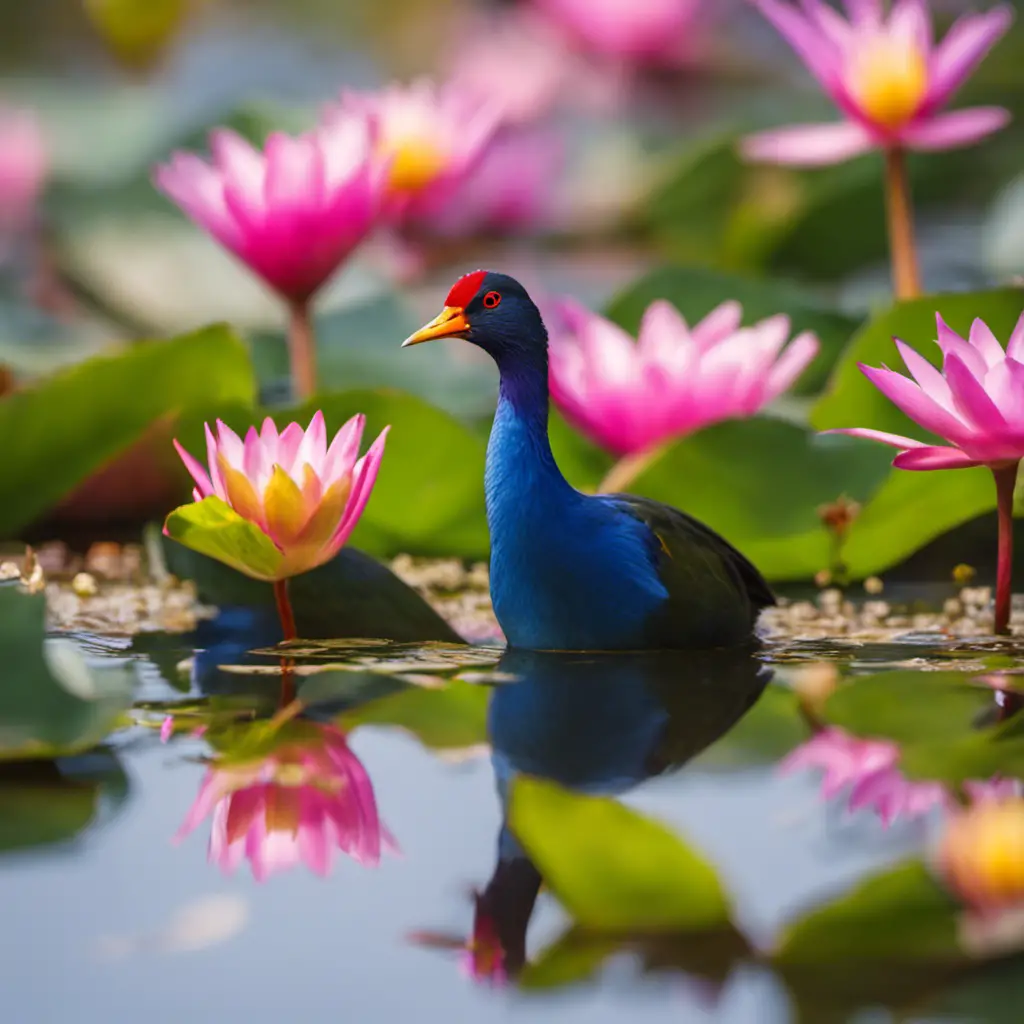
Although not as well-known as the Limpkin, the Purple Gallinule is another remarkable bird species found in the wetlands of Florida. Known for its vibrant plumage and unique behaviors, the Purple Gallinule attracts bird watchers and nature enthusiasts alike.
Here are four interesting facts about this beautiful bird:
Appearance: The Purple Gallinule has a stunning mix of colors, including purple, blue, green, and yellow. Its long legs and large feet are adapted for walking on floating vegetation in wetland ecosystems.
Feeding Habits: These birds are omnivorous, feeding on a variety of plants, insects, and small vertebrates. Their long toes and claws enable them to easily grasp and manipulate their food.
Breeding Behavior: During courtship, the male performs an elaborate display, including vocalizations and dancing. Nests are built in dense vegetation near water, and both parents share incubation and chick-rearing responsibilities.
Conservation Status: While the Purple Gallinule is not currently considered endangered, habitat loss and degradation pose significant threats. Conservation efforts are crucial to protect their wetland habitats and ensure their long-term survival.
Understanding the unique characteristics and importance of bird species like the Purple Gallinule is essential for bird conservation and the preservation of Florida’s wetlands.
Common Moorhen
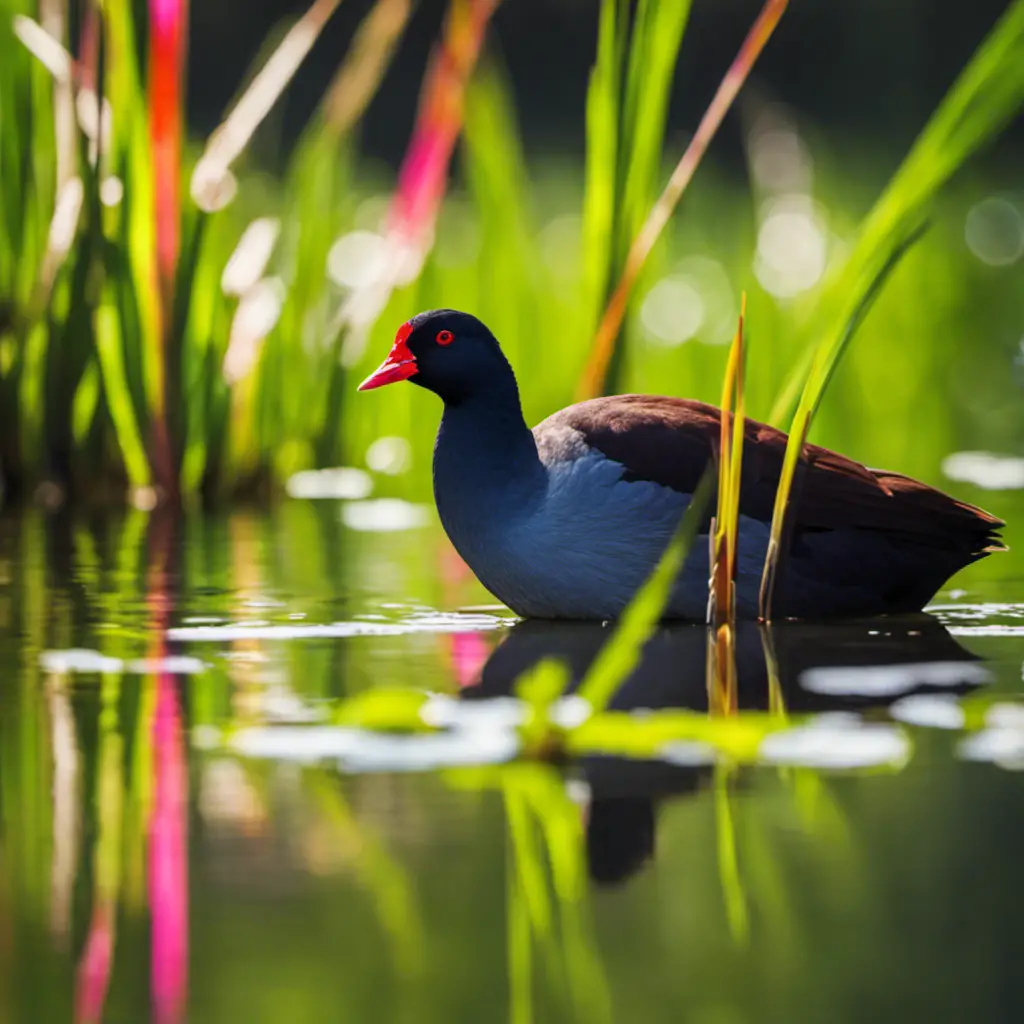
An interesting fact about the Common Moorhen is that it is commonly found in wetland habitats across North America, Europe, and Asia. This species, scientifically known as Gallinula chloropus, is a medium-sized bird that belongs to the rail family. The Common Moorhen is known for its distinctive red bill with a yellow tip and its grayish-black plumage.
When it comes to mating habits, Common Moorhens are monogamous and form long-term pair bonds. During the breeding season, which typically occurs from spring to summer, they engage in elaborate courtship displays to attract a mate. The male performs various displays, such as bowing, calling, and offering food to the female. Once a pair bond is formed, they work together to build a nest.
Nesting behavior of Common Moorhens is fascinating. They construct nests made of plant material, such as reeds and grasses, in dense vegetation near the water’s edge. The female typically lays a clutch of 6-8 eggs, which are incubated by both parents for about three weeks. After hatching, the parents continue to care for the chicks, feeding them a diet of insects, small fish, and aquatic vegetation. The young birds fledge after around 40-50 days.
To summarize, the Common Moorhen is a widely distributed wetland bird known for its mating habits and nesting behavior. Its monogamous nature, courtship displays, and collaborative nest-building make it an intriguing species to study in the avian world.
American Coot
Our research team has recently observed a significant increase in the American Coot’s population, and many scientists attribute this growth to favorable environmental conditions and abundant food resources. The American Coot, a medium-sized water bird found in North America, is known for its unique behavior and adaptability.
Here are four key aspects of the American Coot’s bird behavior:
Sociality: American Coots are highly social birds and can be found in large flocks, especially during the breeding season. They engage in cooperative behaviors, such as communal feeding and communal defense against predators.
Feeding: American Coots are omnivorous and have a diverse diet. They primarily feed on aquatic plants, but also consume insects, small fish, and other invertebrates. Their ability to adapt their feeding habits to available food resources contributes to their population growth.
Nesting: American Coots build floating nests made of reeds, grasses, and other plant materials. They construct their nests in dense vegetation near water bodies, providing protection for their eggs and young.
Swimming: American Coots are excellent swimmers, using their lobed toes and powerful legs to propel themselves through the water. They are capable of diving underwater to forage for food, staying submerged for short durations.
Understanding these aspects of the American Coot’s behavior is crucial for further research and conservation efforts aimed at ensuring the continued success of their population.
Frequently Asked Questions
How Do These Pink Birds Get Their Vibrant Color?
Pink birds get their vibrant color through a process called diet-induced pigmentation. The significance of their pink feathers lies in their ability to attract mates and signal reproductive fitness. This adaptation is common in various bird species worldwide.
Are Pink Birds Native to Florida or Are They Migratory?
Pink birds in Florida exhibit both native and migratory behavior. This is an important topic to explore as it helps us understand the impact of habitat loss on pink bird populations in the region.
What Is the Average Lifespan of These Pink Birds?
The average lifespan of pink birds, including those in Florida, varies depending on the species. For example, the American flamingo can live up to 40 years in the wild. Pink bird populations may face threats from habitat loss and climate change.
Do Pink Birds Have Any Predators in Florida?
The presence of predators in Florida can have a significant impact on the pink bird population. Understanding the relationship between pink birds and their predators is crucial for conservation efforts and maintaining a balanced ecosystem.
Are There Any Conservation Efforts in Place to Protect These Pink Bird Species in Florida?
Efforts are being made to protect pink bird species in Florida through various conservation strategies. These initiatives include addressing the impact of climate change on populations and implementing wetland restoration projects to support their habitat and conservation.
Conclusion
In conclusion, Florida is home to a variety of pink birds. These avian species contribute to the vibrant biodiversity of the region and their unique pink plumage adds to the visual appeal of Florida’s landscapes. The Roseate Spoonbill, Flamingo, American Flamingo, Scarlet Ibis, Roseate Tern, Limpkin, Purple Gallinule, Common Moorhen, and American Coot are some of the pink birds found in Florida. The presence of these pink birds showcases the diverse ecosystems and habitats that support their existence in the state.

An avid ornithologist, zoologist and biologist with an unwavering passion for birds and wild animals.
Dr. Wilson’s journey in ornithology began in childhood and led him to obtain a Ph.D. in Ornithology from the prestigious Avian Research Institute. He has worked closely with renowned experts in the field and conducted extensive research and field studies globally.

